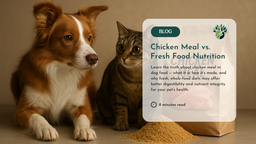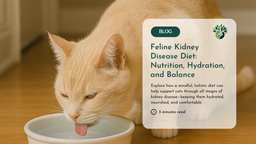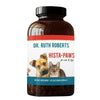Did you know that your pet’s ability to move and stay active impacts more than just their energy levels? 🐾 If you’ve ever wondered why your pet seems a little sluggish or if their digestion isn’t quite right, you’re not alone. Many holistic-minded pet parents, like you, are searching for natural, preventative ways to support their furry family members.
So, here’s the big question: Could something as simple as movement hold the key to your pet’s overall well-being? The answer is a resounding “yes.”
In fact, mobility isn’t just about helping your dog or cat jump on the couch or chase a toy. It’s deeply connected to their gut health, immune system, and even brain function. But how can you make sure your pet stays active and healthy without overwhelming them—or yourself?
To get a deeper look at this fascinating connection, Dr. Ruth Roberts will host a live discussion that breaks it all down step by step. From uncovering the surprising science behind mobility to practical tips you can start using today, this session is packed with insights every pet parent needs. Stay tune!
💡If you’re ready to learn how movement can transform your pet’s health and how to start making small, impactful changes, keep reading—or better yet, watch the video for a front-row seat to Dr. Roberts’ expert advice.
👉 Ready to take the next step? Let’s dive into how you can support your pet’s mobility naturally!
Why Does My Pet’s Mobility Matter so Much?
It’s a question many pet parents are asking, especially as their furry friends grow older or begin showing signs of slowing down. What if I told you that keeping your pet active isn’t just about burning off extra energy—it’s actually key to their overall health? From aiding digestion to supporting brain function, mobility plays a much larger role than most of us realize.
If you’re looking for natural, science-backed ways to help your pet thrive, keep reading. This guide will explore how simple changes in activity and diet can transform your pet’s health.
The Role of Mobility in Your Pet’s Health
How Does Moving More Help Your Pet Feel Better?
When your pet stays active, their whole body benefits. Movement helps keep their gut working efficiently, which means better digestion and nutrient absorption. It also boosts their immune system, helping them fight off illnesses, and even sharpens brain function. In short, mobility is about much more than muscles and joints—it’s the foundation for a happy, healthy life.
How Can You Tell If Your Pet is Struggling with Mobility?
Keep an eye out for these early signs:
-
Slower movement or hesitation to climb stairs.
-
Stiffness after sleeping or resting.
-
Reluctance to play or go on walks.
If you notice any of these, it’s time to take action! Small changes now can make a big difference later.
How Can You Get Your Pet Moving Every Day?
It doesn’t have to be complicated! Try these simple, fun ideas to keep your furry friend active:
-
Playtime for Dogs: A game of fetch or tug-of-war is not only fun but also great exercise.
-
Interactive Toys for Cats: Laser pointers or feather toys can get even the laziest cat on their feet.
-
Daily Walks: If you have a dog, aim for at least two walks a day. For cats, leash training is an option worth exploring!
Diet’s Role in Supporting Mobility
Did you know that what they eat can significantly impact their joint health, muscle strength, and flexibility? From anti-inflammatory foods to key nutrients that support cartilage and bone health, diet is a powerful tool in keeping your furry friend active and agile. Let’s explore how the right nutrition can help your pet move comfortably and thrive!
What should your pet eat to stay strong and active?
The right diet is critical for maintaining muscle mass and supporting mobility, especially in aging pets.
-
High-Quality Proteins: Look for natural, protein-rich options like fresh chicken or beef.
-
Omega-3 Fatty Acids: Found in fish oil, they can reduce inflammation and keep joints healthy.
-
Balanced Fresh Food: Homemade diets, like Dr. Ruth Roberts’ CrockPet Diet, can ensure your pet gets all the nutrients they need without unnecessary fillers or preservatives.
💡 Tip: Avoid low-protein diets unless absolutely necessary. Muscle loss caused by insufficient protein can make mobility issues worse.
Should You Really Cut Back on Protein for Kidney Disease?
Not necessarily! Many vets still recommend low-protein diets for kidney issues, but studies show this can lead to muscle loss, especially in older pets. A better approach? Focus on higch-quality proteins and monitor phosphorus levels instead.
💡 Real-World Example: One dog with early-stage kidney disease thrived on a balanced fresh food diet tailored to support kidney health, maintaining strong muscles and mobility well into their senior years.
Conclusion
Keeping your pet active and mobile is one of the simplest yet most impactful ways to support their overall health. From improving gut function to boosting immune health and even sharpening brain function, movement is more than exercise—it’s a foundation for a healthier, happier life.
So, what’s your next step? Start small: incorporate daily play sessions, introduce gentle mobility exercises, or explore natural dietary options that help maintain muscle mass. Your pet’s body will thank you, and you’ll see the results in their energy and joy.
💡 Want to learn more about holistic pet care?
👉 Explore our latest blogs for expert tips and insights on everything from mobility to nutrition.
👉 Ready to take it further? Schedule a one-on-one strategy session to create a personalized wellness plan for your furry companion.
👉Watch this video and get expert advice from Dr. Ruth Roberts on how to enhance your pet's mobility and ease joint pain naturally.
Remember, you’re not alone in this journey—every step you take brings your pet closer to living their best life. Keep exploring, keep learning, and most importantly, keep moving!















